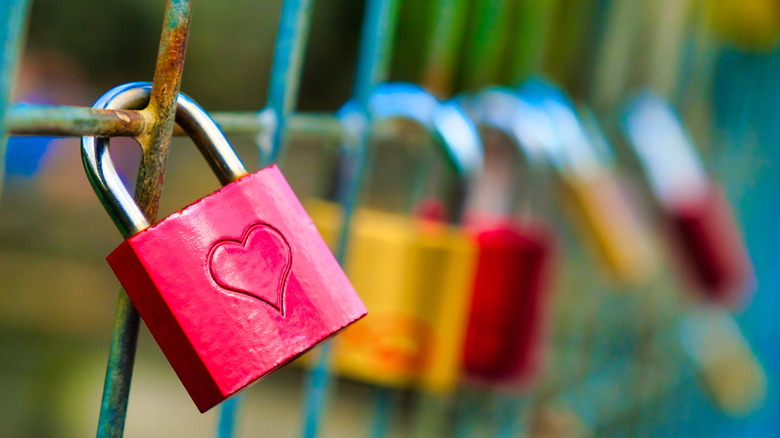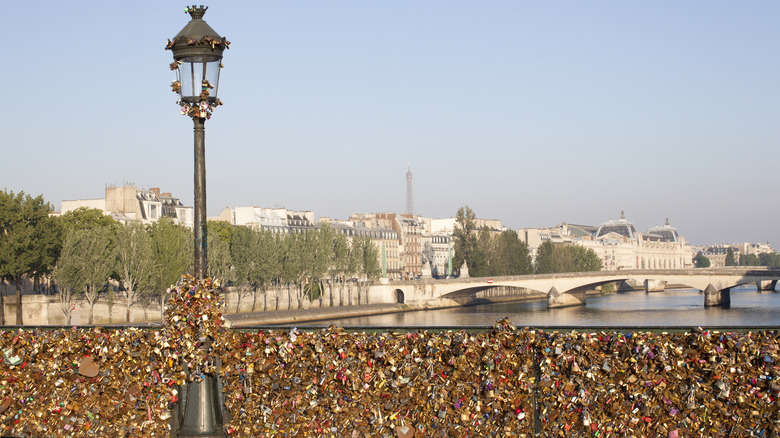Why Do People Put Locks On Bridges? (And Why You Shouldn't)
One of the main appeals of traveling is to experience new cities, new cultures, and new worlds. Whether you're going to another state or another country, the primary goal of travel is to expand your horizons and see what else the world has to offer. Typically, most travelers and tourists try to take a piece of their destination with them, either in the form of photos or souvenirs. However, there's one trend where people are leaving something behind instead: padlocks.
If you go to any major city these days and walk across a bridge, chances are you'll see at least a handful of padlocks attached at various points. You may have even wondered why the locks were there and what purpose they served.
Well, the story is pretty romantic when you understand the meaning behind these "love locks," but the reality is actually much less so. In fact, it's gotten to the point where the city in which this tradition originated is fighting back against the practice. So, let's put on our detective hats and uncover the mystery of why people put locks on bridges (and why you shouldn't).
How the love locks trend started
According to the website Love Locks Online, the tradition of love locks began in ancient China. The process works like this: two lovers inscribe their initials on a padlock (either with a permanent marker or by carving them into the metal), then fix the lock to a specific place and throw the keys away. The symbolism is that the love the couple shares is now locked in place, unbreakable and lasting.
The tradition became somewhat popular in Italy, thanks to the book (and subsequent film) "I Want You" by Frederico Moccia, published in 2006. However, in the modern era, love locks didn't become hugely popular until 2008. Somewhat ironically, the trend blew up in the "world's unfriendliest city," Paris. The target of the first love locks was the Pont De Arts Bridge, and it didn't take long for thousands upon thousands of locks to show up seemingly overnight.
But Paris isn't the only city being inundated with love locks. Lovers around the world participate in the practice, affixing locks to various pieces of infrastructure. However, because of the Parisian influence, most of these locks find their way to a bridge, most likely adding to the symbolism of the practice. For example, one of the iconic spots from your favorite movies, the Brooklyn Bridge, has been a popular target for love locks in recent years.
Why shouldn't you put locks on bridges?
Between 2008 and 2015, an estimated 700,000 padlocks were attached to the Pont De Arts bridge in Paris. Although a single lock weighs just a few ounces, having so many was equivalent of adding the weight of 20 elephants to the bridge. As a result, a section of the railing collapsed into the river. Afterward, the city removed all locks and has continued to do so ever since. There's even an activist group, No Love Locks, that advocates against the practice and goes after influencers and brands that try to incorporate the imagery into their marketing.
The main problem with love locks is that they add stress and weight to existing infrastructure. Further exacerbating the issue is that many lovers like to perform the practice in historical cities, like Georgia's oldest city and walkable gem, Savannah. These infrastructure pieces were not built to hold so many locks, and the danger of a collapse (plus the cost of repair) is too high.
But what if you're trying to put a lock on a spot that isn't already crowded? Isn't that okay? Well, it's still a tricky situation. First, if you do it, that could signal others to put their locks on the same spot, turning a lock-free locale into a potential hazard. Second, especially in Paris, many people toss their keys into the river. Then, the metal rusts and creates toxic residue. Overall, while the meaning behind a love lock can be romantic, it's often more trouble than it's worth. We recommend finding a different tradition that isn't so destructive.


